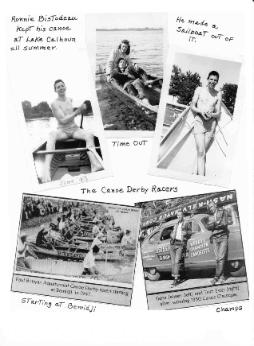
I recently learned something about the Minneapolis Aquatennial that I never knew before, that part of the Aquatennial included canoe races. How I could have escaped that fact, I don’t know. I was once a real canoe enthusiast. My high school boyfriend, Ronnie Bistodeau, (North High) had a canoe he kept docked at the Lake Calhoun boat ramp and we had many a joyful time sailing around Calhoun, Lake of the Isles and adjoining lakes. I say “sailing,” because he had his canoe equipped with a sail set in a wood block in the middle of the canoe, necessitating less energy in the operation of the thing. Actually, some paddling would have been better exercise!
The way I belatedly learned about the canoe races was from the book The Mississippi Courts, written by Amy Lucsebrink, Mike Fahey and Kenny Fosberg. Called the Paul Bunyon Aquatennial Canoe Derby, it began in 1940 and was typically held the week before the start or the Aquatennial. It was said to be one of the most challenging and exhausting competitions in the country, lasting three days and spanning 450 miles. It started in Bemidji and ended at the West Broadway Bridge. To go along with the race, eight Minnesota towns held regional dance contests introducing the “Aquatrot,” official dance of the festivities. These towns were Bemidji, Grand Rapids, Palisade, Aitken, Brainerd, Little Falls, St. Cloud and Anoka.
One of the top racers in the derby was four-time champion, Gene Jensen of Brooklyn Park. He mentioned in an article in the Minneapolis Star Tribune that he was lucky to find his partner, an old schoolmate, Tom Estes. Before finding Estes he said he “couldn’t find friends who were dumb enough to run a 450 mile race.” Wow, such nice sentiments! The Jensen/Estes team did very well winning the race four times; in 1948, 1949, 1950 and 1960. Some of his memories depicted how intense and physically demanding the race was. Jensen said, “That marathon stuff is tough on you. After racing 8 to10 hours a day on the Mississippi, you were so darn tired, you hoped you didn’t die in your sleep.”
To prepare for the race, Jensen trained four days a week, after the winter ice thawed. The canoes were different back then. Being made of wood, they became soaked with water and as the race went on, became heavier and heavier. They could change from 80 lbs. to 90-100 lbs. making the latter part of the race more difficult.
Another tough canoe racer was Alvin Wisneck, 69, of Brooklyn Center, who said, “The $1500 first place prize for the grueling race was good, but it was nothing for all that work.” The only time he raced in the canoe derby his weight dropped from 172 to 150 lbs.
The end of the Aquatennial canoe race occurred in 1960. Gene Jensen speculated that he believed the event ended because it wasn’t getting enough national publicity to justify it. Or maybe it didn’t get enough local publicity. As for Gene Jensen, he went on to design canoes and paddles, and invented the world renowned bent-shaft paddle!
Note: Taken from the book, The Mississippi Courts, authors stated above.